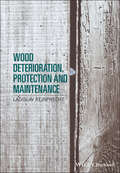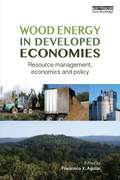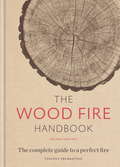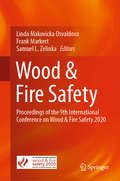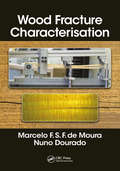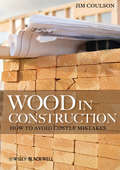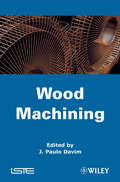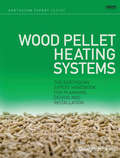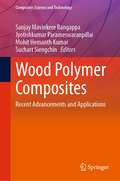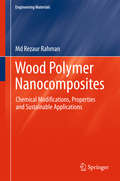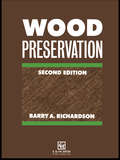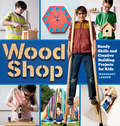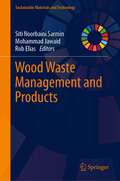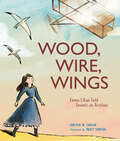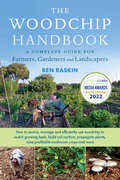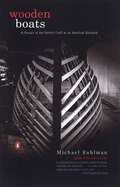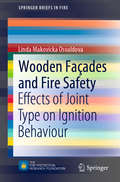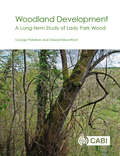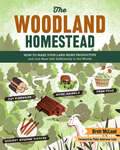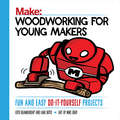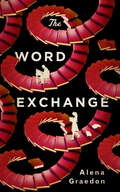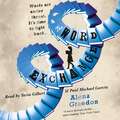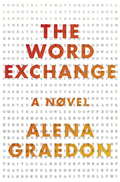- Table View
- List View
Wood Deterioration, Protection and Maintenance
by Ladislav ReinprechtWood Deterioration, Protection and Maintenance provides an up to date discussion of the natural durability of wood, wood degradation processes, and methods of structural and chemical protection of wood. Modern active substances in wood preservatives and the relationships between preservative properties, the anatomical structure and moisture content of wood and protective processes involving pressure and/or diffusion driving forces are fully illustrated.
Wood Energy in Developed Economies: Resource Management, Economics and Policy
by Francisco X. AguilarThere has been a recent resurgence of interest in wood energy as part of a sustainable range of renewable energy options. This book addresses the current gap in the energy and public policy literature for a reference book that compiles the most-recent wood energy assessments, and evaluates current and potential future wood energy uses and the role for public policy to foster efficient use of the most-widely consumed renewable energy in the world. It brings together a group of expert authors covering topics from forest management, operations and engineering, to socio-economics and energy policy perspectives. It thus covers practical issues such as silviculture, harvesting, processing, comparative cost estimates, public policy tools and market effects. As such the book provides a comprehensive review of the complex dimensions of wood energy as well as practical guidance for professionals, researchers and advanced students. It will also provide invaluable guidance for economic development agencies, practitioners and policy-makers, when evaluating the impacts of wider wood energy adoption as part of a strategy for sustainable energy generation. The main focus is on industrialised production and developed economies, particularly the USA and Europe.
The Wood Fire Handbook: The complete guide to a perfect fire
by Vincent Thurkettle'Sound, well-seasoned advice [on] how to bring wood fires into our lives.' - BBC CountryfileThe Wood Fire Handbook shows you that the soothing effect of dancing flames and glowing embers is a simple pleasure to have in our lives. Understanding everything that underpins the perfect wood fire makes it even more enjoyable. Vincent Thurkettle's handbook is the essential companion and manual.The expert insight and knowledge in this book allow everyone to rediscover the skills of previous generations and savour the delight of a perfect wood fire in all its incarnations.Contents include...Understand which trees make the best firewoodLearn how to split, season, and store woodLay the perfect fireMake an ingenious campfireChoose wood for its scent...and much more!This revised edition features updated information on wood-burning stoves, 'clean' wood and other environmental considerations.
The Wood Fire Handbook: The complete guide to a perfect fire
by Vincent Thurkettle'Sound, well-seasoned advice [on] how to bring wood fires into our lives.' - BBC CountryfileThe Wood Fire Handbook shows you that the soothing effect of dancing flames and glowing embers is a simple pleasure to have in our lives. Understanding everything that underpins the perfect wood fire makes it even more enjoyable. Vincent Thurkettle's handbook is the essential companion and manual.The expert insight and knowledge in this book allow everyone to rediscover the skills of previous generations and savour the delight of a perfect wood fire in all its incarnations.Contents include...Understand which trees make the best firewoodLearn how to split, season, and store woodLay the perfect fireMake an ingenious campfireChoose wood for its scent...and much more!This revised edition features updated information on wood-burning stoves, 'clean' wood and other environmental considerations.
Wood & Fire Safety: Proceedings of the 9th International Conference on Wood & Fire Safety 2020
by Linda Makovicka Osvaldova Frank Markert Samuel L. ZelinkaThis proceedings volume presents new scientific works of the research workers and experts from the field of Wood Science & Fire.It looks into the properties of various tree species across the continents affecting the fire-technical properties of wood and wood-based materials, its modifications, fire-retardant methods and other technological processes that have an impact on wood ignition and burning. The results of these findings have a direct impact on Building Construction and Design describing the fire safety of wooden buildings, mainly large and multi-story ones. The results of these experiments and findings may be applied, or are directly implemented into Fire Science, Hazard Control, Building Safety which makes the application of wood and wood materials in buildings possible, while maintaining strict fire regulations.One part of the contributions focuses on the symbiosis of the material and the fire-fighting technologies. Wood burning has its own specific features, therefore, the fire protection technologies need to be updated regularly. It also includes the issue of the intervention of fire-fighting and rescue teams in the fires of wooden buildings. Presentations deal with the issue of forest fires influenced by the climate changes, relief, fuel models based on the type and the age of the forest stand.
Wood Fracture Characterization
by Marcelo F. de Moura Nuno DouradoWood Fracture Characterization provides a guide to the application of modern fracture mechanics concepts to wood materials used in structural engineering, which commonly involve discontinuities and irregularities. The authors cover the tests, data reduction schemes and numerical methods devised for wood structural applications, based on cohesive zone analysis, and used to validate experimental-based methodologies. Five detailed Case Studies are included to link theory with engineering practice. This important new text explains the basics of fracture mechanics, and extends them as needed to cover the special behaviour of an anisotropic wood materials.
Wood in Construction: How to Avoid Costly Mistakes
by Jim CoulsonWood in Construction – How to Avoid Costly Mistakes focuses on the basic principles and appropriate use of wood in construction and illustrates how to avoid or minimise problems, to ensure that wood performs as expected when used in a construction application. Based on the author’s extensive experience of manufacturing processes and practical applications in the timber, construction, joinery, shop-fitting and furniture industries, Wood in Construction provides a guide to using wood in building in the real world. It describes the main causes of difficulty when using wood, and shows how to avoid or minimise problems, reducing the difficulties for the architect, engineer or specifier, builder and building owner. Technical enough to explain why things should be done in specific ways, but also practical enough to demonstrate how to use wood correctly and avoid doing the wrong things, this is an invaluable resource for construction specifiers (architects, engineers), carpenters, structural engineers, building surveyors, small/medium sized builders.
Wood Machining
by J. Paulo DavimWood as an engineering material can be technically defined “as a hygroscopic, orthotropic, biological, and permeable material having extreme chemical diversity and physical complexity with structures, that vary extensively in their shape, size, properties and function”. Therefore, using wood to its best advantage and most efficiency in engineering applications, specific characteristics or chemical, physical and mechanical properties must be considered. The products are divided into two classes, solid wood and composite wood products. Solid wood includes shipbuilding, bridges, flooring, mine timbers, etc. Composite wood products include insulation board, plywood, oriented strand board, hardboard and particle board. In recent years, the machining of wood products has acquired great importance due the short supply of wood and increasing environmental awareness among users and manufacturers. The optimization of the machining process centers around the mechanism of chip formation, tool wear, workpiece surface quality, crack initiation and propagation of different types of wood. Other factors are also humidity, temperature, static preloads, and vibrations that can affect the wood during the machining process. The book provides some fundamentals and recent research advances on machining wood and wood products.
Wood Pellet Heating Systems: The Earthscan Expert Handbook on Planning, Design and Installation (Earthscan Expert Ser.)
by Dilwyn JenkinsWood Pellet Heating Systems is a comprehensive handbook covering all aspects of wood pellet heating technology. The use of wood pellets as an alternative heating fuel is already well established in several countries and is becoming widespread as fossil fuel prices continue to rise and awareness of climate change grows. Wood pellets are a carbon-neutral technology, convenient to use, and can easily be integrated into existing central heating systems or used in independent space heaters. This fully-illustrated and easy-to-follow guide shows how wood-pellet heating works, the different types of systems – from small living room stove systems to larger central heating systems for institutions – how they are installed, and even how wood pellets are manufactured. Featuring examples from around the world, it has been written for heating engineers and plumbers who are interested in installing systems, home owners and building managers who are considering purchasing a system, advanced DIYers, building engineers and architects, but will be of interest to anyone who requires a clear guide to wood pellet technology.
Wood Polymer Composites: Recent Advancements and Applications (Composites Science and Technology)
by Sanjay Mavinkere Rangappa Jyotishkumar Parameswaranpillai Mohit Hemanth Kumar Suchart SiengchinThis book comprehensively covers the different topics of wood polymer composite materials mainly synthesis methods for the composite materials, various characterization techniques to study the superior properties and insights on potential advanced applications. It also discusses the chemistry, fabrication process, properties, applications, recycling and life cycle assessment of wood polymer composites. This is a useful reference source for both engineers and researchers working in composite materials science as well as the students attending materials science, physics, chemistry and engineering courses.
Wood Polymer Nanocomposites
by Md Rezaur RahmanThis book shows how chemical modifications influence some properties of wood nanocomposites. It describes suitable and effective chemical modifications that strengthen the physico-mechanical, thermal and morphological properties of wood. The authors provide intuitive explanation of the various types of chemical modifications applied to polymer cell walls in wood. They emphasize the reaction changes in wood cell walls due to the chemical modifications. Increased mechanical strength, improved thermal stability as well as the efficient retardancy against fungi attack are described. This book concludes summarizing the potential applications of wood-based nanocomposites taking into account sustainability and economic aspects.
Wood Preservation
by B A RichardsonThe new edition of this comprehensive study of national and international research and application into wood preservation is both well detailed and broad in coverage. The text covers the history of preservation: the anatomy of timbers and their breakdown, preservation principles, materials and methods.
Wood Shop: Handy Skills and Creative Building Projects for Kids
by Margaret LarsonCome on, kids: grab a hammer, step up to the workbench, and get ready to measure, saw, drill, and make cool things! Wood Shop is an exciting introduction for today’s kids to an age-old tradition: building with wood. With step-by-step photographs and clear instructions, aspiring woodworkers learn essential skills such as how to drive a nail, use a power drill, “measure twice, cut once,” and saw correctly. Then the fun begins, with 17 cool and creative projects kids can build to furnish the wood shop, decorate their bedrooms and homes, and create their own play equipment. Favorite projects include Tic-Tac-Toe-To Go!, One-Board Birdhouse, a Tool Tote, and a hanging Twinkle Light. Wood Shop is the perfect gift for tinkerers, young makers, fans of LEGO toys, and aspiring carpenters and engineers. This publication conforms to the EPUB Accessibility specification at WCAG 2.0 Level AA.
Wood Waste Management and Products (Sustainable Materials and Technology)
by Siti Noorbaini Sarmin Mohammad Jawaid Rob EliasThis book examines the application of wood waste in various advancements in environmental fields, such as construction, renewable energy, bio-absorbent, and agricultural and wood-based material. Featuring illustrations, and tables summarizing the latest research, it gathers up-to-date information on the application of various types of wood waste which could be applied in a practical manner to materially reduce nuisance created by fallout of wood-based industries from different sources. Given its scope, the book is a valuable reference book for research students and reference resources for researchers, academics, and industrial scientists working in the field of wood waste management and their utilization.
Wood, Wire, Wings: Emma Lilian Todd Invents an Airplane
by Kirsten W. LarsonThis riveting nonfiction picture book biography explores both the failures and successes of self-taught engineer Emma Lilian Todd as she tackles one of the greatest challenges of the early 1900s: designing an airplane.Emma Lilian Todd's mind was always soaring--she loved to solve problems. Lilian tinkered and fiddled with all sorts of objects, turning dreams into useful inventions. As a child, she took apart and reassembled clocks to figure out how they worked. As an adult, typing up patents at the U.S. Patent Office, Lilian built the inventions in her mind, including many designs for flying machines. However, they all seemed too impractical. Lilian knew she could design one that worked. She took inspiration from both nature and her many failures, driving herself to perfect the design that would eventually successfully fly. Illustrator Tracy Subisak's art brings to life author Kirsten W. Larson's story of this little-known but important engineer.
The Woodchip Handbook: A Complete Guide for Farmers, Gardeners and Landscapers
by Ben RaskinThe first and only complete guide to sourcing and using woodchip—an abundant, inexpensive, and ecologically sustainable material—for savvy growers and landscapers at any scale, from farm to garden to greenhouse. The Woodchip Handbook is the essential guide to the many uses of woodchip both in regenerative agriculture and horticulture. Author Ben Raskin, Head of Horticulture and Agroforestry at the Soil Association, draws on his extensive practical experience using woodchip, provides the latest research from around the world, and presents inspiring case studies from innovative farmers. The book explores and unlocks the tremendous potential of woodchip to enhance soil health and plant growth: As a natural mulch for weed suppression, temperature buffering, and water conservation As a growing medium for propagating plants As a decomposing source of warmth for hotbeds in the greenhouse or hoop house As a carbon-rich compost ingredient that supports beneficial fungi and microorganisms As a powerful soil health booster, when applied as small-sized ramial chipped wood As an ideal substrate for growing many kinds of edible or medicinal mushrooms As a sustainable, versatile, and durable material for foot paths and ornamental landscaping Some of these techniques, like mulching—or the renewable harvest potential from coppicing and pollarding trees—have been around forever. Yet there is always new science to be discovered, such as the role that salicylic acid from willow woodchip can play in preventing tree diseases or promoting livestock health when used as a bedding material. Whether you are a commercial grower or farmer, a permaculture practitioner, or a serious home gardener producing your own fruit and vegetables, The Woodchip Handbook will show you how to get the most out of this readily available and renewable material.
Wooden Boats: In Pursuit of the Perfect Craft at an American Boatyard
by Michael RuhlmanThere are fewer than 10,000 wooden boats in America, but the circulation of WoodenBoat magazine exceeds 180,000. What is it about these boats that has captured the popular imagination? With his "lively blend of reportage [and] reflection" (Los Angeles Times), Michael Ruhlman sets off for a renowned boatyard in Martha's Vineyard to follow the construction of two boats-Rebecca, a 60-foot modern pleasure schooner, and Elisa Lee, a 32-foot powerboat. Filled with exquisite details and stories of the sea, this exciting exploration of a nearly forgotten craft and the colorful personalities involved will enthrall wooden boat owners as well as craftspeople of every stripe, nature enthusiasts, and fans of compelling nonfiction.
Wooden Façades and Fire Safety: Effects of Joint Type on Ignition Behaviour (SpringerBriefs in Fire)
by Linda Makovicka OsvaldovaThis book presents the results of an experiment assessing the impact of spruce wood joints on the creation and development of fire when these joints are applied within a façade. The book includes an extensive analysis of wooden cladding, which is a flammable material in which the elements are connected lengthwise using various types of joint. The parameters of the experiment, as well as the setting, material criteria and evaluation criteria are described in detail. The results confirm that the joint type used has an impact on the selected evaluation criteria and thus also on the potential spread of fire.
Woodland Development
by George F. Peterken Edward P. MountfordIn 1944 Lady Park Wood (45 hectares of woodland in Gloucestershire and Monmouthshire, UK) was set aside indefinitely by the Forestry Commission so that ecologists could study how woodland develops naturally. Since then, in a unique long-term study, individual trees and shrubs have been recorded at intervals, accumulating a detailed record of more than 20,000 individual beech, sessile oak, ash, wych elm, small-leaved lime, large-leaved lime, birch, hazel, yew and other species. In the seven decades since the study started, the wood has changed; trees grew, died and regenerated, and drought, disease and other events shaped its destiny. Each tree and shrub species reacted in its own way to changes in the wood as a whole and to changes in the fortunes of its neighbours. Meanwhile, the wild fauna, flora and fungi also responded, leaving the wood richer in some groups but poorer in others. In this landmark book, beautifully illustrated throughout, George Peterken and Edward Mountford, summarise the ongoing results of the Lady Park Wood study, highlighting its unique place in nature conservation and its significance to ecology in general. It also builds on experience at Lady Park Wood and elsewhere to discuss in particular: the role and maintenance of long-term ecological studies; the concept and form of natural woodland; the role of minimum-intervention policies in woodland nature conservation; near-to-nature forestry; and the desirability and practicalities of re-wilding woodlands.
Woodland Development: A Long-term Study of Lady Park Wood
by George Peterken Edward MountfordIn 1944 Lady Park Wood (45 hectares of woodland in Gloucestershire and Monmouthshire, UK) was set aside indefinitely by the Forestry Commission so that ecologists could study how woodland develops naturally. Since then, in a unique long-term study, individual trees and shrubs have been recorded at intervals, accumulating a detailed record of more than 20,000 individual beech, sessile oak, ash, wych elm, small-leaved lime, large-leaved lime, birch, hazel, yew and other species. In the seven decades since the study started, the wood has changed; trees grew, died and regenerated, and drought, disease and other events shaped its destiny. Each tree and shrub species reacted in its own way to changes in the wood as a whole and to changes in the fortunes of its neighbours. Meanwhile, the wild fauna, flora and fungi also responded, leaving the wood richer in some groups but poorer in others. In this landmark book, beautifully illustrated throughout, George Peterken and Edward Mountford, summarise the ongoing results of the Lady Park Wood study, highlighting its unique place in nature conservation and its significance to ecology in general. It also builds on experience at Lady Park Wood and elsewhere to discuss in particular: the role and maintenance of long-term ecological studies; the concept and form of natural woodland; the role of minimum-intervention policies in woodland nature conservation; near-to-nature forestry; and the desirability and practicalities of re-wilding woodlands.
The Woodland Homestead: How to Make Your Land More Productive and Live More Self-Sufficiently in the Woods
by Philip Ackerman-Leist Brett McLeodPut your wooded land to work! This comprehensive manual shows you how to use your woodlands to produce everything from wine and mushrooms to firewood and livestock feed. You’ll learn how to take stock of your woods; use axes, bow saws, chainsaws, and other key tools; create pasture and silvopasture for livestock; prune and coppice trees to make fuel, fodder, and furniture; build living fencing and shelters for animals; grow fruit trees and berries in a woodland orchard; make syrup from birch, walnut, or boxelder trees; and much more. Whether your property is entirely or only partly wooded, this is the guide you need to make the best use of it.
Woodworking for Young Makers: Fun and Easy Do-It-Yourself Projects
by Loyd Blankenship Lane BoydLearning to be a maker has never been more fun. Full-color cartoons and drawings lead you through the steps needed for making a wizard wand, a sanding block, a charging station for your phone or tablet, and a sturdy box with a hidden compartment. You'll learn how to choose and use the right tools, measure and cut properly, sand, glue, and finish your woodworking projects to make them look great.This is the perfect guide for young people who want to do woodworking at home, at school, or at a local makerspace. It teaches fundamental skills and unlocks creativity. No prior experience or knowledge of tools is required. Everything you need to know is explained in the text and cartoons.This easy-to-follow guide is suitable for all ages. It features:Lavish cartoons and line artStep-by-step instructions with full-color artProjects that are fun and usefulBasic skills, handy tips, and safety precautionsWoodworking is the most universally useful of crafts. In this book, young adults will learn to work successfully with standard hand tools found in any garage or basement workshop and in any school shop class. The skills learned here will unlock a lifetime of useful skills and satisfying accomplishments.
The Word Exchange
by Alena Graedon'Spine-tingling' New York Times'A fast-paced, thrill-a-minute début novel' New Yorker'Graedon knows how to ratchet up mystery' EsquireWORDS ARE UNDER THREAT. IT'S TIME TO FIGHT BACK...Imagine a world without words. A world in which books, libraries and newspapers are things of the past. A world where personal devices provide all you could want or need.Anana Johnson and her father, Doug, are hard at work on the final edition that will ever be printed of the English Dictionary. But one evening, Doug disappears and Anana unearths a single written clue: ALICE.In the battle to save her father, Anana discovers secret societies, dark incinerator rooms and underground passages. Above all, she finds a world that faces ruin from the dark side of technology. Praise for The Word Exchange'A nervy, nerdy dystopian thriller' New York Times Book Review'A propulsive, twisty future-noir' Daily Beast'Spectacular' Karen Russell, author of Swamplandia! and Vampires in the Lemon Grove'Dazzling' Slate'Wildly ambitious, darkly intellectual and inventive' Kirkus Reviews, starred review
The Word Exchange
by Alena GraedonIn the not-so-distant future, the forecasted 'death of print' has become a reality. Bookstores, libraries, newspapers, and magazines are a thing of the past, as we spend our time glued to handheld devices called Memes that not only keep us in constant communication but have become so intuitive as to hail us taxis before we leave our offices, order takeout at the first growl of a hungry stomach, and even create and sell language itself in a marketplace called the Word Exchange.Anana Johnson works with her father, Doug, at the North American Dictionary of the English Language(NADEL), where Doug is hard at work on the final edition that will ever be printed. Doug is an intellectual who fondly remembers the days when people used e-mail to communicate - or even actually spoke to one another. One evening, Doug disappears from the NADEL offices, leaving a single written clue: ALICE. It's a code word he and Anana devised to signal if one of them ever fell into danger....Joined by Bart, her bookish NADEL colleague (who is secretly in love with her), Anana's search for her father will take her into dark basement incinerator rooms, underground passages of the Mercantile Library, meetings of a secret society designed to save the written word, the boardrooms of the evil online retailing giant Synchronic, and ultimately to the hallowed halls of the Oxford English Dictionary - the spiritual home of the written word. As Anana pieces together what is going on, and Bart falls victim to the strange 'word flu' that is spreading worldwide, the very future of language is at stake....Read by Tavia Gilbert and Paul Michael Garcia(p) 2014 Blackstone Audio
The Word Exchange
by Alena GraedonA fiendishly clever dystopian novel for the digital age, The Word Exchange is a fresh, stylized and decidedly original debut about the dangers of technology and the power of the printed word. In the not so distant future, the forecasted "death of print" has become a reality. Bookstores, libraries, newspapers and magazines are a thing of the past, as we spend our time glued to handheld devices called Memes that not only keep us in constant communication, but have become so intuitive as to hail us cabs before we leave our offices, order take out at the first growl of a hungry stomach, and even create and sell language itself in a marketplace called The Word Exchange. Anana Johnson works with her father Doug at the North American Dictionary of the English Language (NADEL), where Doug is hard at work on the final edition that will ever be printed. Doug is a staunchly anti-Meme, anti-tech intellectual who fondly remembers the days when people used email (everything now is text or video-conference) to communicate--or even actually spoke to one antoher for that matter. One evening, Doug disappears from the NADEL offices leaving a single writen clue: ALICE. It's a code word he and Anana devised to signal if one of them ever fell into harm's way. And thus begins Anana's journey down the proverbial rabbit hole. . . Joined by Bart, her bookish NADEL colleague (who is secretly in love with her), Anana's search for Doug will take her into dark basement incinerator rooms, underground passages of the Mercantile Library, secret meetings of the anonymous "Diachronic Society," the boardrooms of the evil online retailing site Synchronic, and ultimately to the hallowed halls of the Oxford English Dictionary--the spiritual home of the written word. As Ana pieces togehter what is going on, and Bart gets sicker and sicker with the strange "Word flu" that has spread worldwide causing people to speak in gibberish, Alena Graedon crafts a fresh, cautionary tale that is at once a technological thriller, and a throughtful meditation on the price of technology and the unforeseen, though very real, dangers of the digital age.
